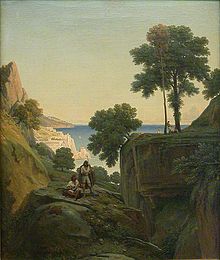Claude-Félix-Théodore Aligny
Claude-Félix-Théodore Aligny (called Caruelle d'Aligny) (born January 24, 1798 in Saint-Aubin-des-Chaumes , Nièvre department , Burgundy ; † February 24, 1871 in Lyon ) was a French painter, draftsman and graphic artist . He was one of the older representatives of the classical style in French landscape painting . His historical landscapes, large, firm and strict in composition, were criticized for their too garish coloring; its accessories are mostly mythological. It is considered to be the forerunner of the Barbizon school .
life and work
Aligny came from a family of artists. He was a student in Paris with Jean Baptiste Regnault and Louis Etienne Watelet . In the tradition of Pierre-Henri de Valenciennes , he specialized in landscapes. He lived in Rome for a long time and befriended Camille Corot there. In 1842 he was awarded the Cross of the Legion of Honor.
He painted in Paris in the church of St-Étienne-du-Mont . From 1860 to 1871 he was director of the École des Beaux-Arts in Lyon. His paintings hang a. a. at the Louvre in Paris , the Metropolitan Museum of Art in New York , the Boston Art Museum , the Cleveland Museum of Art , the Getty Center in Los Angeles and the Fitzwilliam Museum in Cambridge.
Works (selection)
- Prometheus bound
- The Good Samaritan (Amiens, Picardy Museum)
- Haymaking in the Campagna
Web links
literature
- Gerhard Finckh (ed.), Barbizon Adventure: Landscape, Painting and Photography from Corot to Monet , von-der-Heydt-Museum, Wuppertal 2007, ISBN 978-3892020660
- Geraldine Norman (ed.), Nineteenth-century Painters and Painting: A Dictionary , Thames & Hudson, London 1977, ISBN 0500232490
- Marie-Madeleine Aubrun, Théodore Caruelle d'Aligny, 1798-1871: catalog raisonné de l'oeuvre peint, dessiné, gravé , Paris 1988
Individual evidence
- ^ G. Norman
- ^ Document at the Base Léonore of the French Ministry of Culture, accessed on September 20, 2012
| personal data | |
|---|---|
| SURNAME | Aligny, Claude-Félix-Theodore |
| ALTERNATIVE NAMES | Aligny, Caruelle d '; Caruelle d'Aligny; Aligny, Caruelle d '; Aligny, Théodore Caruelle d ' |
| BRIEF DESCRIPTION | French painter |
| DATE OF BIRTH | January 24, 1798 |
| PLACE OF BIRTH | Saint-Aubin-des-Chaumes, ( Nièvre department ) |
| DATE OF DEATH | February 24, 1871 |
| Place of death | Lyon |
